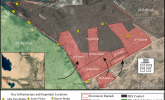 |
 |
Ramadi Control Map, Nov. 22, 2015 (Central Ramadi)
The ISF began a major operation to penetrate central Ramadi on December 22, 2015. An element lead by the Counter-Terrorism Service (CTS) entered Ramadi from al-Humaira area south of Ramadi into the city’s southern neighborhoods. A separate CTS force entered from Ta’mim area southwest of Ramadi into al-Haouz neighborhood in southern Ramadi using a pontoon bridge, as all of Ramadi’s bridges have been heavily damaged. ISW has confirmed that formations from the 8thIraqi Army (IA) Division, local police, and Anbar tribal fighters have also entered the city. ISW was not able to confirm or deny the participation of elements of the 16th IA Division, a formation that was trained and armed by the Coalition. At the time of publication, ISW confirmed the presence of the ISF in al-Haouz, al-Dhubbat, al-Bakir, and al-Aramil neighborhoods in southern Ramadi, with possible but unconfirmed operations in al-Malab and al-Andalus neighborhoods.
The ISF appear to have consolidated control over areas additional areas southwest of Ramadi, including the 8th Brigade Base (also known as Camp Warrar) west of Ramadi and the neighborhoods of 5 Kilo and Ta’mim, as these areas have witnessed no significant kinetic activity for weeks. ISW is changing the status of these areas to “ISF / Tribal Fighter control.” The operation to fully clear the city of ISIS still faces significant obstacles. ISIS’s manpower within the city is vastly diminished – Operation Inherent Resolve spokesperson Steve Warren estimated on December 22 that ISIS only had 250 to 350 fighters left in the city. Nevertheless, the ISF continue to encounter resistance in the form of IEDs, tunnel networks, and suicide bombings. At least one attacker with an SVEST or SVBIED attempted to target security forces in southern Ramadi on December 22 following previous SVBIED and direct fire attacks to the north on December 15 and east of Ramadi on December 16. The ISF are still in the process of clearing the northern areas of Juraishi, Albu Thiab, and Albu Faraj. Neighborhoods outside of central Ramadi to the north and south thus remain contested, though the ISF maintain a heavy presence.
Recapturing the city will be a major victory for the ISF and PM Abadi, but significant challenges lie ahead. For one, Ramadi will remain exposed to counter-attacks by ISIS, particularly from the north from ISIS-held Hit district, if the ISF shifts forces away from Ramadi to focus on other operations. Large sections of the city suffered heavy damage during the operation, and resettling internally-displaced persons (IDPs) may prove to be both a logistical and a security challenge. Finally, it is unclear who will ultimately hold and secure Ramadi against counter-attacks by ISIS. The ISF have stated that local tribal forces and local police would secure recaptured areas, but ISF formations will also be required to hold the area. It remains uncertain whether those formations are responsive to the Iraqi government or consist of forces loyal to Iranian proxy militias. Iranian proxy militias and the Federal Police, which have close ties with Iranian proxy militias, are positioned to the east of the city near Habaniya base. These forces may advance into Ramadi’s eastern suburbs and towards the city center in order to claim credit from the ISF for participation and obtain leverage over the final composition of the security forces in the city. Iranian proxy militias made a similar move in Tikrit in April 2015, positioning themselves around some of Tikrit’s entrances in order to control who could enter and exit the city. Intervention by Iranian proxy militias in Ramadi would undermine ISF operations and the overall security of the area by inflaming sectarian tensions.
